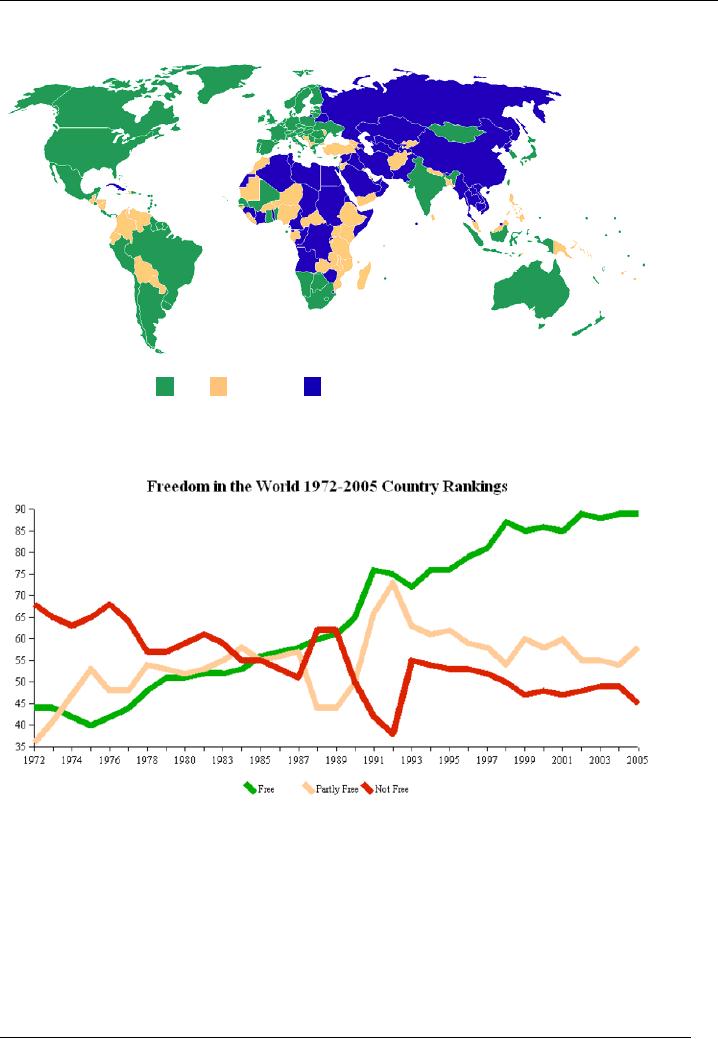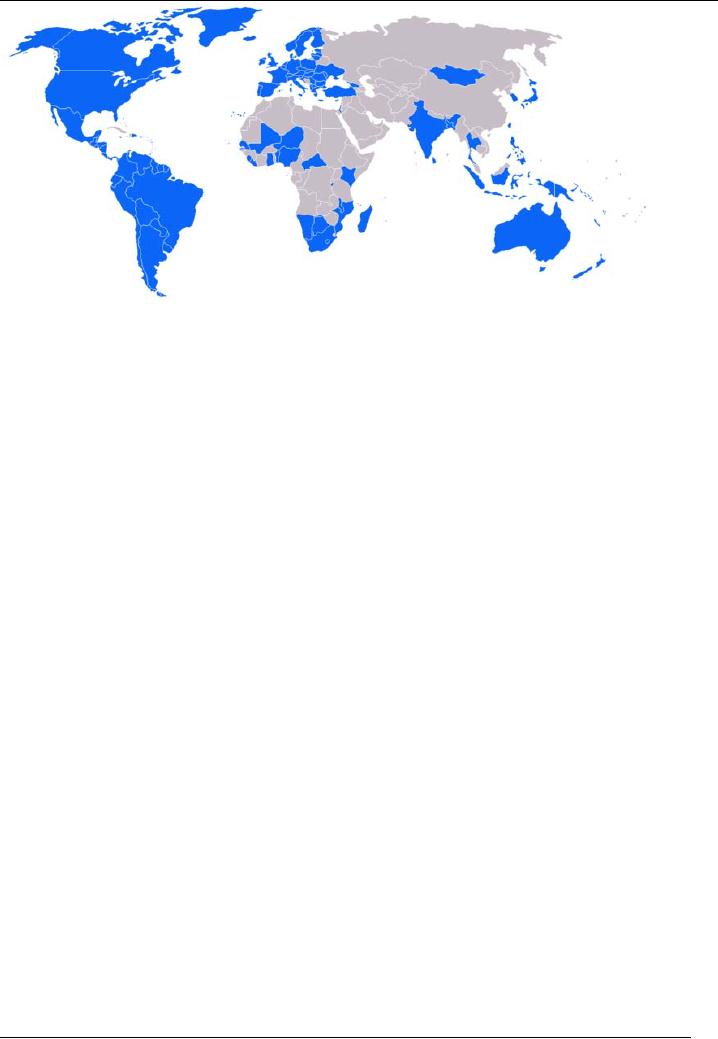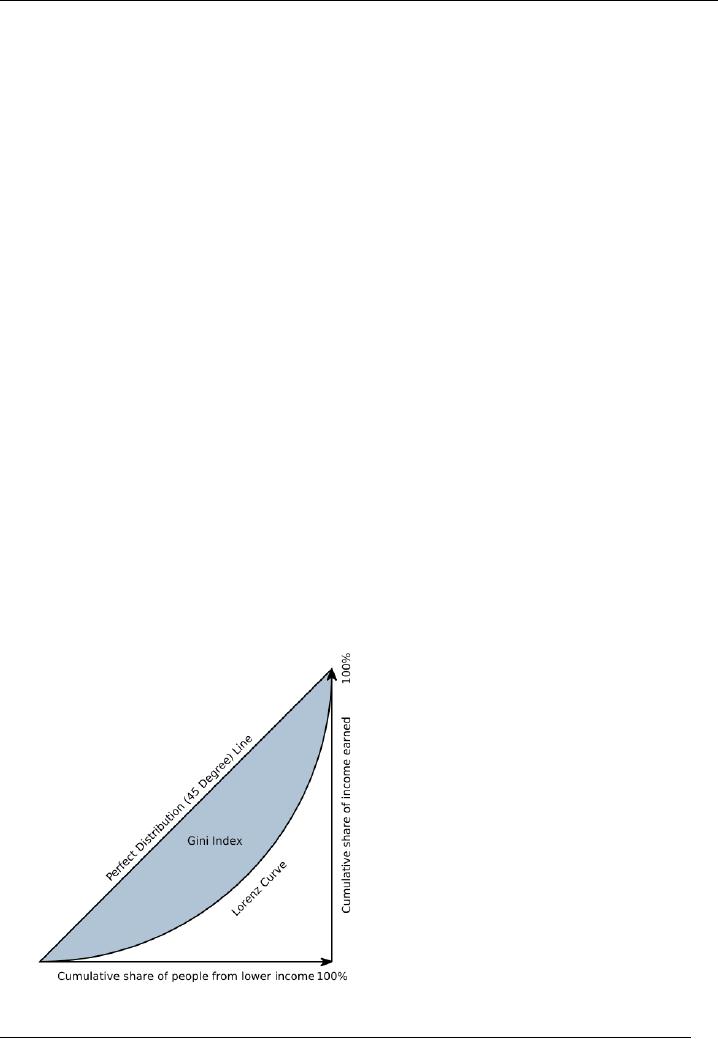 |
REPORTS:Criticisms of Freedom House Methodology, GROSS NATIONAL HAPPINESS |
| << HUMAN DEVELOPMENT INDEX (HDI):Methodology, |
| SECTORS OF A SOCIETY: SOME BASIC CONCEPTS:PUBLIC SECTOR, PRIVATE SECTOR >> |

Human
Resource Development (HRM-627)
VU
Lesson
22
REPORTS
This
map reflects the findings of
Freedom House's 2007 survey
Freedom in the World, concerning the
state of
world
freedom in 2006.
Free
Partly
Free
Not
Free
This
graph shows the number of nations in the
different categories given above
for the period for which
there
are
surveys, 1972-2005
68

Human
Resource Development (HRM-627)
VU
Countries
highlighted in blue
are
designated "Electoral Democracies" in
Freedom House's 2006
survey
Freedom
in the World.
Since
1972, (1978 in book form)
Freedom House publishes an annual
report, Freedom in the World, on
the
degree
of democratic freedoms in nations and
significant disputed territories around the world, by
which it
seeks
to assess the current state of civil
and political rights on a scale
from 1 (most free) to 7
(least free). These
reports
are often used by political
scientists when doing research.
The ranking is highly
correlated with
several
other
ratings of democracy also
frequently used by
researchers.
In
its 2003 report, for
example, Canada (judged as
fully free and democratic)
got a perfect score of a "1" in
civil
liberties
and a "1" in political rights,
earning it the designation of "free."
Nigeria got a "5" and a
"4", earning it
the
designation of "partly free,"
while North Korea scored the
lowest rank of "7-7", and
was thus dubbed "not
free."
Nations are scored from 0 to
4 on several questions and the
sum determines the rankings.
Example
questions:
"Is the head of state and/or
head of government or other chief
authority elected through
free and
fair
elections?", "Is there an independent
judiciary?", "Are there free
trade unions and peasant
organizations or
equivalents,
and is there effective collective
bargaining? Are there free
professional and other
private
organizations?"
Freedom House states that the rights
and liberties of the survey is derived in
large measure
from
the Universal Declaration of Human
Rights.
The
research and ratings process
involved two dozen analysts
and more than a dozen
senior-level academic
advisors.
The eight members of the core
research team headquartered in
New York, along with 16
outside
consultant
analysts, prepared the country
and territory reports. The
analysts used a broad range of
sources of
information--including
foreign and domestic news
reports, academic analyses,
nongovernmental organizations,
think
tanks, individual professional
contacts, and visits to the
region--in preparing the reports.
The
country and territory
ratings were proposed by the
analyst responsible for each
related report. The
ratings
were
reviewed individually and on a
comparative basis in a series of
six regional meetings--Asia-Pacific,
Central
and
Eastern Europe and the Former
Soviet Union, Latin America
and the Caribbean, Middle
East and North
Africa,
Sub-Saharan Africa, and
Western Europe--involving the analysts,
academic advisors with
expertise in
each
region, and Freedom House staff. The
ratings were compared to the previous
year's findings, and
any
major
proposed numerical shifts or
category changes were
subjected to more intensive scrutiny.
These reviews
were
followed by cross-regional assessments in
which efforts were made to
ensure comparability and
consistency
in the findings. Many of the key
country reports were also
reviewed by the academic
advisers.
Regardless,
such a process contains
elements of subjectivity.
The
survey's methodology is reviewed
periodically by an advisory committee of political
scientists with
expertise
in methodological issues.
Freedom
House also produces annual reports on
press freedom (Press
Freedom Survey),
governance in the
nations
of the former Soviet Union (Nations
in Transit), and
countries on the borderline of democracy
(Countries
at
the Crossroads). In
addition, one-time reports have included a
survey of women's freedoms in the
Middle East.
Freedom
House generally uses standard
geographic regions for its
reports, though it groups the
countries of
the
Middle East and North
Africa together, separately from
Sub-Saharan Africa; and it
still uses the
arguably
outdated
concept of Western Europe, to include
countries such as Turkey and
Cyprus, while
categorizing
Central
and Eastern Europe
separately -- a division stemming
from the Cold War era
which ignores the
69

Human
Resource Development (HRM-627)
VU
eastwards
expansion of such organizations
such the EU and NATO.
However, these groupings have
nothing
to
do with the individual country
ratings; they're merely used
to make nations easier to find
when perusing their
reports,
and also for comparative
statistics between the modern day
and the ratings of decades
past.
Criticisms
of Freedom House Methodology
The
methodology Freedom House uses
for its reports has been
criticised for its perceived
bias towards
countries
with pro-US positions. By relying on
'experts' or 'judges', the methodology is
claimed to fall into
the
what
is described as 'systematic measurement
error': "Regardless of the direction of distortions,
it is highly
likely
that every set of indicators
formed by a single author or organization
contains systematic
measurement
error.
The origin of this measure
lies in the common methodology of
forming measures. Selectivity
of
information
and various traits of the judges
fuse into a distinct form of
bias that is likely to
characterize all
indicators
from a common publication.
Other
activities
In
addition to these reports,
Freedom House participates in advocacy
initiatives, currently focused on
North
Korea,
Africa, and religious freedom. It has
offices in a number of countries, where it
promotes and assists
local
human rights workers and
non-government organizations.
On
January 12, 2006, as part of
a crackdown on unauthorized nongovernmental
organizations, the Uzbek
government
ordered Freedom House to suspend operations in
Uzbekistan. Resource and Information
Centers
managed
by Freedom House in Tashkent, Namangan,
and Samarkand offered access
to materials and books on
human
rights, as well as technical equipment,
such as computers, copiers
and Internet access. The
government
warned
that criminal proceedings could be
brought against Uzbek staff
members and visitors following
recent
amendments
to the criminal code and Code on
Administrative Liability of Uzbekistan.
Other human rights
groups
have been similarly threatened
and obliged to suspend
operations.
Freedom
House is a member of the International
Freedom of Expression Exchange, a global
network of more
than
70 non-governmental organisations that
monitors free expression
violations around the world
and
defends
journalists, writers and others
who are persecuted for
exercising their right to freedom of
expression.
The
Financial
Times has
reported that Freedom House is one of
several organisations selected by the
State
Department
to receive funding for
'clandestine activities' inside Iran. In
a research study, with Mr Ackerman
acting
as chief adviser, Freedom House sets
out its conclusions: "Far
more often than is generally
understood,
the
change agent is broad-based,
non-violent civic resistance - which
employs tactics such as boycotts,
mass
protests,
blockades, strikes and civil
disobedience to de-legitimate
authoritarian rulers and
erode their sources
of
support, including the loyalty of their
armed defenders.
Regarding
regime change, the organization states
"Freedom House works directly with men
and women around
the
world to expand the political rights
and civil liberties they experience in
their countries. More
specifically,
Freedom
House focuses on initiatives that
contribute to long-term stability
and growth in countries,
such as
strengthening
civil society, promoting open government,
defending human rights, and facilitating
the free flow
of
information and ideas. While
these activities - and the liberties they
represent - may be threatening to
some
repressive
governments, Freedom House does
not initiate or sponsor
regime change or popular
revolutions.
We
help men and women of
good will to improve their
own societies.
Criticism
and praise
As
noted in the section on organization
above, Freedom House receives
most of its funding from the
US
government,
and prominent US government officials
reside on its board, most
notably neo-conservatives.
These
ties to state power and
rightist institutions have
been criticized. The organisation states
that its board of
trustees
contains Democrats, Republicans
and Independents who are a
mix of business and labor
leaders,
former
senior government officials, scholars and
journalists.
Noam
Chomsky describes how
Freedom House "had interlocks with AIM,
the World Anticommunist
League,
Resistance
International, and U.S. government
bodies such as Radio Free
Europe and the CIA, and
has long
served
as a virtual propaganda arm of the
(U.S) government and international
right wing. He justifies this
claim
by
presenting a series of national
elections generally considered as
staged, that the Freedom House
observers
however
found "fair". He also
criticizes the unconditional support of
Freedom House members to all
U.S.
international
military interventions, and the
expenditure of "substantial resources in criticizing the
media for
insufficient
sympathy with U.S.
foreign-policy ventures and
excessively harsh criticism of U.S.
client states."
70

Human
Resource Development (HRM-627)
VU
In
May 2001, the Committee on
Non-Governmental Organizations of the United
Nations heard
arguments
pro
and against Freedom House.
Representatives of Cuba described the
organization as a U.S. foreign
policy
instrument
linked to the CIA and "submitted
proof of the politically motivated,
interventionist activities the
NGO
(Freedom House) carried out
against their Government".
They also pointed out the
lack of criticism of
U.S.
human rights violations in the annual
reports. These violations
are well documented by other
reports, such
as
those of Human Rights Watch.
Other countries such as China
and Germany also offered
criticism. The
Russian
Federation representative also inquired
"why this organization, an NGO which
defended human rights,
was
against the creation of the International
Criminal Court". The United
States representative denied the
links
between
Freedom House and CIA and
pointed out that "his
country was not immune
from criticism from
Freedom
House" and that "the
organization was a human rights organization,
which sought to represent
those
who
did not have a
voice".
We
must also remember that the
organisation was formed by the United
States government, which
already
makes
it a not neutral-starting point. On a
similar line, Freedom House has
also been criticized by
Justin
Raimondo,
who claims that "Freedom House
standards are elastic, bending to the
dictates of American foreign
policy.
Freedom
House reports have criticized both the
United States and its major
allies to a certain extent,
for
example
in its 2006 report on the
U.S. and Israel.
Nevertheless, Israel earns good
scores in political and
civil
rights,
despite international perception that the
Israeli state violates the rights of Arab
populations. Evidently,
Freedom
House has also been critical of
some traditional US allies,
such as Saudi Arabia and
Chile under
Pinochet,
classifying them as "Not Free" It was
also strongly critical of apartheid South
Africa and military
dictatorships
in Latin America. However, it could be
argued that not to criticize the
lack of political freedom of
these
regimes would be
contradictory.
Despite
the criticism, many thinkers defend the
organization's dedication to the promotion of
human rights.
Writing
in the rightist National Review
Online, John R. Miller, a
research professor at the George
Washington
University's
Elliott School, states
that
Freedom
House has unwaveringly raised the
standard of freedom in evaluating fascist
countries,
Communist
regimes, and plain old,
dictatorial thugocracies. Its
annual rankings are read
and used in
the
United Nations and other
international organizations, as well as
by the U.S. State Department.
Policy
and aid decisions are
influenced by Freedom House's report.
Those fighting for freedom
in
countries
lacking it are encouraged or discouraged
by what Freedom House's report
covers. And
sometimes
-- most importantly -- their
governments are moved to greater
effort.
Miller
nevertheless criticized the organization in
2007
GINI
COEFFICIENT
Graphical
representation of the Gini
coefficient
71

Human
Resource Development (HRM-627)
VU
The
Gini
coefficient is a
measure of inequality of income
distribution or inequality of wealth
distribution. It is
defined
as a ratio with values
between 0 and 1: the numerator is the
area between the Lorenz
curve of the
distribution
and the uniform distribution line; the
denominator is the area under the uniform
distribution line.
Thus,
a low Gini coefficient
indicates more equal income
or wealth distribution, while a high
Gini coefficient
indicates
more unequal distribution. 0
corresponds to perfect equality (e.g.
everyone has the same
income) and
1
corresponds to perfect inequality (e.g.
one person has all the
income, while everyone else
has zero income).
The
Gini coefficient requires
that no one have a negative
net income or wealth.
The
Gini coefficient was developed by the
Italian statistician Corrado Gini
and published in his 1912
paper
"Variabilità
e mutabilità" ("Variability and
Mutability").
The
Gini coefficient is also commonly
used for the measurement of the
discriminatory power of rating
systems
in
credit risk management.
The
Gini
index is the
Gini coefficient expressed as a
percentage, and is equal to the
Gini coefficient
multiplied
by
100. (The Gini coefficient is
equal to half of the relative mean
difference.)
Advantages
of Gini coefficient as a measure of
inequality
·
The
Gini coefficient's main advantage is
that it is a measure of inequality by
means of a ratio analysis,
rather
than a variable unrepresentative of most
of the population, such as per
capita income or
gross
domestic
product.
·
It
can be used to compare
income distributions across
different population sectors as
well as countries,
for
example the Gini coefficient
for urban areas differs from
that of rural areas in many
countries
(though
the United States' urban and
rural Gini coefficients are
nearly identical).
·
It
is sufficiently simple that it
can be compared across
countries and be easily interpreted.
GDP
statistics
are often criticised as they do
not represent changes for
the whole population; the
Gini
coefficient
demonstrates how income has
changed for poor and rich.
If the Gini coefficient is rising
as
well
as GDP, poverty may not be
improving for the majority of the
population.
·
The
Gini coefficient can be used
to indicate how the distribution of
income has changed within
a
country
over a period of time, thus it is
possible to see if inequality is
increasing or decreasing.
·
The
Gini coefficient satisfies
four important principles:
o
Anonymity: it
does not matter who the
high and low earners
are.
o
Scale
independence: the
Gini coefficient does not
consider the size of the economy, the
way it is
measured,
or whether it is a rich or poor country
on average.
o
Population
independence: it
does not matter how
large the population of the country
is.
o
Transfer
principle: if
income (less than the difference), is
transferred from a rich
person to a poor
person
the resulting distribution is more
equal.
Disadvantages
of Gini Coefficient as a Measure of
Inequality
The
Gini coefficient of different
sets of people cannot be averaged to
obtain the Gini coefficient of all
the
people
in the sets: if a Gini coefficient
were to be calculated for
each person it would always
be zero. When
measuring
its value for a large,
economically diverse country, a
much higher coefficient than each of
its regions
has
individually will
result.
For
this reason the scores calculated
for individual countries
within the EU are difficult to
compare with the
score
of the entire US: the overall value
for the EU should be used in that
case, 31.3, which is still
much lower
than
the United States', 45. Using
decomposable inequality measures
(e.g. the Theil index
T
converted by 1
-
e
-
T
into a
inequality coefficient) averts
such problems.
The
Lorenz curve may understate
the actual amount of inequality if richer
households are able to use
income
more
efficiently than lower income
households. From another point of
view, measured inequality
may be the
result
of more or less efficient
use of household incomes.
Economies
with similar incomes and
Gini coefficients can still
have very different income
distributions. This is
because
the Lorenz curves can have
different shapes and yet
still yield the same Gini
coefficient. As an extreme
example,
an economy where half the
households have no income,
and the other half share
income equally has a
Gini
coefficient of ½; but an economy
with complete income equality,
except for one wealthy household
that
has
half the total income, also
has a Gini coefficient of ½. In
practice, such distributions
don't exist, and
therefore,
the impact of different but
realistic curves is less
obvious.
72

Human
Resource Development (HRM-627)
VU
GROSS
NATIONAL HAPPINESS
Gross
National Happiness (GNH) is an attempt to
define quality of life in more
holistic and
psychological
terms
than Gross National
Product.
The
term was coined by Bhutan's King
Jigme Singye Wangchuck in
1972. It signaled his commitment
to
building
an economy that would serve
Bhutan's unique culture based on Buddhist
spiritual values. Like
many
worthy
moral goals it is somewhat easier to
state than to define, nonetheless, it
serves as a unifying vision
for
the
Five Year planning process
and all the derived planning
documents that guide the
economic and
development
plans to the country.
While
conventional development models stress
economic growth as the ultimate objective, the
concept of
GNH
claims to be based on the premise
that true development of human society
takes place when material
and
spiritual
development occur side by side to
complement and reinforce each
other. The four pillars of GNH
are
the
promotion of equitable and sustainable
socio-economic development, preservation and
promotion of
cultural
values, conservation of the natural environment,
and establishment of good
governance
Qualitative
and Quantitative Indicators
There
is no exact quantitative definition of
GNH.
GNH
is a qualitative condition that is
often discussed in tandem
with the Genuine Progress
Indicator which,
unlike
GNP, attempts to quantify well-being
and happiness. The two
measures agree, however, that
subjective
measures
like well-being are more relevant
and important than more
objective measures like
consumption.
According
to Daniel Kahneman, a Princeton
University psychologist, the indicator is
measured using a new
technique
called the day reconstruction method. It
consists in recollecting memories of the previous
working
day
by writing a short diary.
Happiness
as Understood by Classical
Liberalism
Under
classical liberal economic
theory happiness was already
an economic measurement used
interchangeably
with
utility as well as the general
welfare. Classical liberal
economists attempt to quantify happiness
through
measurements
in consumption and profits. For
example if X product is consumed in
good quantity for
high
profit,
classical liberal economists
argue that societies know
that this good, and all the
factors used in the
production
of the good, generate a great deal of
happiness for society. It is this
equating of high consumption
levels
with happiness that has
been challenged by proponents of
GNH.
Criticism
of GNH
Critics
allege that because GNH
depends on a series of subjective
judgments about well-being,
governments
may
be able to define GNH in a way that
suits their interests. In the
case of Bhutan, for instance, they
say that
the
government expelled about one hundred
thousand people and stripped them of
their Bhutanese citizenship
on
the grounds that the deportees
were ethnic Nepalese who had
settled in the country illegally.
While this
would
reduce Bhutan's wealth by most
traditional measures such as
GDP, the Bhutan government claims it
has
not
reduced Bhutan's GNH.
Alternative
indicators of economic progress have
also been supported by a number of NGOs
such as the UK's
New
Economics Foundation, and
are employed in some
governments notably in Europe
and Canada.
73
Table of Contents:
- INTRODUCTION TO HUMAN RESOURCE DEVELOPMENT:The Concept and its Dimensions, Targets of Development
- FOUNDATIONS OF HUMAN BEHAVIOR:Attitudes, Personality, Emotional Intelligence
- PERCEPTION:Attribution Theory, Shortcuts Frequently Used in Judging Others
- INTRINSIC MOTIVATION:Why Choose Big Five Framework?, THE OUTCOME OF FIVE FACTOR MODEL
- FIVE FACTOR MODEL:The Basis of Intrinsically Motivated Behavior, Intrinsic Motivation and Values
- MOTIVATION:EARLY THEORIES OF MOTIVATION, Designing Motivating Jobs
- The Motivation Process:HOW TO MOTIVATE A DIVERSE WORKFORCE?,
- INTERPERSONAL COMMUNICATION:PRINCIPLES OF INTERPERSONAL COMMUNICATION
- THE WORLD BEYOND WORDS:DIFFERENCES BETWEEN VERBAL AND NONVERBAL COMMUNICATION, MINDFUL LISTENING
- TRANSACTIONAL ANALYSIS:EGO STATES, Parent Ego State, Child Ego State
- TYPES OF TRANSACTIONS:Complementary Transactions, Crossed Transactions, Ulterior Transactions
- NEURO-LINGUISTIC-PROGRAMMING
- CREATE YOUR OWN BLUEPRINT
- LEADERSHIP:ORGANIZATIONAL DEMOCRACY
- LEADERSHIP:Environment and Strategic Leadership Link, Concluding Remarks
- UNDERSTANDING GROUP BEHAVIOR:Stages of Group Development, Advantages of Group Decision Making
- UNDERSTANDING TEAM BEHAVIOR:TYPES OF TEAMS, Characteristics of Effective Teams,
- EMOTIONAL FACET:PHYSICAL FACET
- HUMAN RESOURCE DEVELOPMENT & THE ROLE OF GOVERNACE:Rule of Law, Transparency,
- HUMAN RESOURCE DEVELOPMENT:The Concept and Its Dimensions, Targets of Development
- HUMAN DEVELOPMENT INDEX (HDI):Methodology,
- REPORTS:Criticisms of Freedom House Methodology, GROSS NATIONAL HAPPINESS
- SECTORS OF A SOCIETY: SOME BASIC CONCEPTS:PUBLIC SECTOR, PRIVATE SECTOR
- NON GOVERNMENTAL ORGANIZATIONS (NGOS):Types, Methods, Management, Citizen organization
- HEALTH SECTOR:Health Impact of the Lebanon Crisis, Main Challenges,
- A STUDY ON QUALITY OF PRIMARY EDUCATION BACKGROUND AND RATIONALE
- ADULT EDUCATION:Lifelong learning
- THE PRACTICAL PERSPECTIVE OF ADULT EDUCATION:Problems of Adult Literacy, Strategies for Educating Adults for the Future
- TECHNICAL & VOCATIONAL EDUCATION:VET Internationally, Technical Schools
- ASSESSING THE LINK BETWEEN INTELLECTUAL CAPITAL FORMATION AND PERFORMANCE OF A UNIVERSITY
- SCIENCE & TECHNOLOGY EDUCATION:Social responsibility, Curriculum content
- ENVIRONMENT:Dark Greens and Light Greens, Environmental policy instruments
- HDI AND GENDER SENSITIVITY:Gender Empowerment Measure
- THE PLIGHT OF INDIAN WOMEN:
- ENTREPRENEURSHIP:Characteristics of entrepreneurship, Advantages of Entrepreneurship
- A REVISIT OF MODULE I & II
- HUMAN DEVELOPMENT & ECONOMIC GROWTH (1975 TO 2003):
- PUBLIC PRIVATE PARTNERSHIP:Origins, The Desired Outcomes of PPPs
- PRINCIPLES OF PUBLIC PRIVATE PARTNERSHIP (PPP):Situation in Pakistan,
- DEVOLUTION REFORMS – A NEW SYSTEM OF GOVERNMENT:
- GOOD GOVERNANCE:Participation, Rule of law, Accountability
- MACROECONOMIC PROFILE OF A COUNTRY: EXAMPLE ECONOMY OF PAKISTAN
- COORDINATION IN GOVERNANCE: AN EXAMPLE OF EU, The OMC in Social Inclusion
- MOBILIZING REGIONAL EDUCATIONAL RESOURCES: THE ASEAN UNIVERSITY NETWORK, A CASE STUDY
- GOVERNMENT PRIORITIES AND POLICIES:Role of Government, Socio Cultural Factors in Implementing HRD Programs